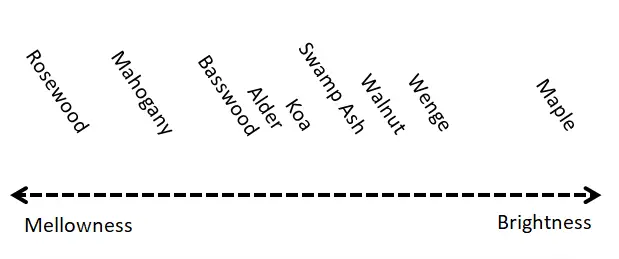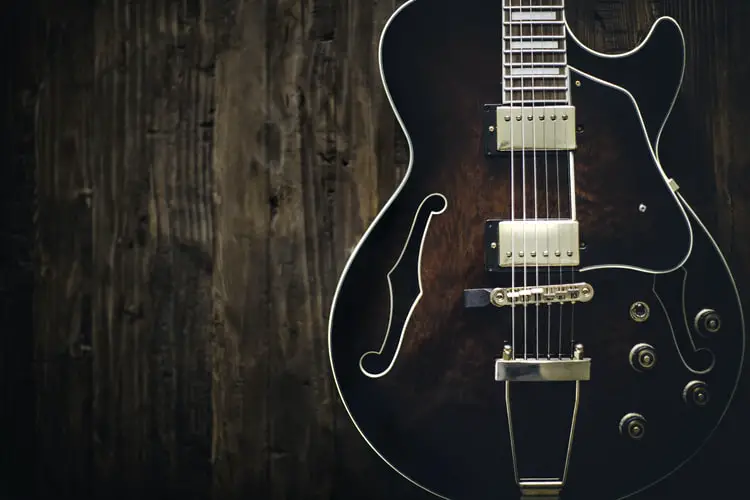Did you know there are over NINE Tone Wood Types? This is important to grasp as each tonewood greatly determines your instrument’s tone to match the style of music you wish to play!
What are the Tonewood Types? There are NINE different types of woods that you will find on more than 95% of ALL guitars produced in the market today! These include Rosewood, Mahogany, Basswood, Alder, Koa, Swamp Ash, Walnut, Wenge, and Maple which all vary between mellowness and brightness.

In this article, I will introduce to you the most common types of wood used for guitar making, and in each section, I also explain the exclusive qualities inherent with those particular types of wood.
Let us jump right in below!
1. Alder
Alder is the type of wood that has a uniform, small pore structure and is commonly used for guitar body construction because of the quality of being relatively light compared to other types of wood. The signature light tan color with the spiral grain wood pattern is one of the signs to help recognize Alder. These increasing-in-size rings don’t just make a nice-looking finish, but they indeed also contribute to strengthening and enhancing the complexity of the guitar tone.

Compared to Basswood, Alder is known for its ability to offer a wider and more balanced tone, whilst retaining equal doses of both highs and lows, with a little less emphasis in the midrange. With all these fine attributes offered at a comparatively low price, it is no surprise that Alder is the most popular body wood, and the chosen wood to build the Fender guitar designs.
2. Basswood
Basswood may be the wood type that’s most suitable for carving work since its timber is particularly soft with very minimal grain. Since its wood structure is so easy to mould and requires very little effort to be cut, it has been chosen to bring into factories to make into numerous applications, including the mass production of the guitar. One interesting thing about this wood type is that though it’s inexpensive, it has been used to make several high-end guitars.

Guitars with bodies built from Basswood are lightweight and particularly known for the soft nature in tonality, which results in a weaker low end. Many players also fancy it because it can produce a fairly even tone that is not too dark and not too bright, as well as offer a good midrange attack. Apart from this, it is also favored for its ability to cut through a mix well.
3. Mahogany
This is the most popularly used body wood type for the back and side of acoustics, and especially appealing to a lot of players due to the wide range of merits they offer at a very affordable price. In fact, it is the wood type that was chosen by Gibson for the construction of the famous Les Paul and SG. Not only cheaper than Rosewood, but Mahogany is also highly workable, offers good durability, impressive resonance, and an overall balanced tone of highs, mids, and lows. The lower-end D-18 is one significant example of a design that employed Mahogany on the back and sides, while its higher-end counterpart –the D-28, is made with Rosewood.

Mahogany’s characteristics are known to add a definite amount of warmth and a typical woody tone to the guitar. In fact, you may find this tone familiar because The Beatles used Gibsons guitars, which used Mahogany in its acoustic parts, in their early recordings. In terms of finish, Mahogany would look best under clear or transparent coating.
4. Swamp Ash
Ash is another wood type favored by Fender besides Alder. Ash used for building guitar bodies is categorized into two types: Northern Ash or hard Ash, and southern Ash or swamp Ash, with the latter more commonly used. However, when referring to swamp/hard Ash, we are actually talking about the region where Ash trees grow instead of a particular type of wood. Growing in two different areas makes these two wood types different in nature, and thus, differing from each other in the guitar tone they produce.

In particular, while hard Ash is inherent with the typical presence of brightness and the ability to provide long-lasting sustain, swamp Ash is known to impart to many of the Fender creations in the 1950s its characteristic warmth. One thing in common with these two types is that they both have large open pores – which makes them less easy to work with. With this typical feature, guitar makers have to fill these pores with lacquer or fillers in the factory so that the surface is smooth enough to apply finishes.
5. Walnut
Walnut is a gorgeous wood type with the signature brown aesthetic. Generally, you can easily recognize this type of wood by its typical luxury-vibe color and the extremely appealing grain patterns. It’s inherent with open pores and relatively heavy weight, but not quite as heavy as Maple.

Concerning tonal attributes, it is known to provide a greater presence of warmth than Maple and is usually employed in the making of electric guitar bodies. Walnut is one of those wood types that look especially attractive under a simple oil coating, but a deep clear gloss finish would also fit its look.
6. Koa
Koa is a wood type that exclusively grows in Hawaii, which explains why its supply is always rather limited. It is one of those types that catch the most attention for its beautiful visual appearance, with visible grains and colors ranging from light to dark golden. Similar to Walnut, guitars made from Koa can look pretty decent with an oil finish, but it’s more commonly known to look best when sprayed clear.

In terms of sound, Koa provides the combined tonal quality of Rosewood and Mahogany, possessing both the warmth of the former and the brightness of the latter. Its tone tends to focus on the upper midrange rather than the highs, which is appealing to players who fancy fundamentals. Koa is commonly used for laminate tops, bodies, and guitar necks.
7. Maple
You can easily recognize Maple by its light color, closed pores, and typical grain patterns. It is a strong and dense wood that’s easier to apply finishes than Ash, which is the reason why it is the most commonly chosen for the guitar neck and fretboard construction. In terms of tone, Maple is known for good sustain and stability, as well as the ability to add brightness to the instrument.

Will all these qualities, it is often chosen by Fender to build their creations’ necks. Similar to Ash, Maple includes 2 types: hard and soft. Hard Maple is tough for factory work, hence its popular application for slimmer-bodied guitars. Soft Maple offers an impressive bright attack compared to other wood types but is in fact still not as bright as the hard variety.
8. Rosewood
Rosewood is not only known to be the most common wood used to make the fretboard, but it’s also famous for the rich brown and purple – aesthetic visual. Overall, Rosewood is the type of wood that lies at the darker end of the tone range. It is associated with rich warmth, impressive resonance, and the ability to provide good volume. Rosewood necks are famously inherent with warm mids and fat lows and have been chosen as the material for guitar necks since the early days of Rock and Roll.

Two of the most popular types of Rosewood include Indian and Brazilian, with the latter variety now in very low stock and extremely rare to be seen. Indian Rosewood, generally speaking, is just the last resort to replace Brazilian Rosewood. It is not only too obviously purple but also not as smooth on the surface as its counterpart. Meanwhile, Brazilian Rosewood is much more favored because of its ability to release bottom notes with better clarity, and highs that resemble bell tone. However, all things considered, using Rosewood for solid guitar construction is not a very smart choice as it’s rare, costly, and quite heavy. Besides this, it also requires a great amount of work to apply lacquer, as the pores need to be filled in advance.
Conclusion
Each type of wood is different, and that’s what makes them so interesting because how it is treated in the factory, how dense and how heavy it is all influence how your guitar looks sounds, and plays. This doesn’t necessarily result in better or worse tonal quality, but rather the unique tone and qualities each wood imparts to the guitar.
Needless to say, the wood types I mentioned in this list don’t include all types of wood available and used by manufacturers for guitar construction. However, the listed wood types are the most popular for guitar making, so I hope that a general knowledge of these types will help you decide which one to buy when it comes to picking a guitar that must serve well to your taste in terms of both the sounding and aesthetics.
If you liked this article and you feel it helped you then please leave a comment and share it with someone who might find it useful. I am actively updating these articles daily and so I will see any comments made within a few days of posting!
You can also visit Parts Of A Guitar? If you want to find more relevant posts to read.
Thank you so much and have a great day!

